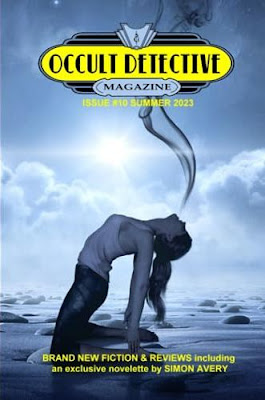“It
was seven years ago, this very day, that Mr Marley left us...”
Or...
“Marley
was dead—as dead as a two-year-old un-responded submission.”
Okay,
I couldn't help the Dickensian reference, but it really has been
seven years—today—since I made my first story submission in
earnest. Late in 2015 I made a few experimental submissions to test
fire the method, and I'd had a few unpaid placements in the previous
two years which encouraged me to get serious about the game, but
January 7th,
2016, is the date inscribed in my memory as the day I really launched
my bid to be a writer.
Maybe
seven is the charm—they used to call it a magical number in the
ancient world, and with the seventh year complete I have in some ways
positioned myself for success to come. This is my annual review of
progress/state of play post, and 2022 has been an interesting
excursion in many ways.
Here's the raw data:
In the last seven
years, I have made 2849 submissions (401 in the last 365 days). I
have 196 placements (14.53:1submission/acceptance ratio, up from,
15.11:1 last year, which was am improvement on 16.008:1 the year
before, indicating a steady positive decrease over time, regardless
of all other factors). I currently have about 70 stories out, and my
record is around 105-110, though to be fair there must have been a
fair few multiple submissions and dead/in limbo subs among that lot.
These figures also indicate 2583 rejections, giving a
rejection/acceptance ratio of 13.178, also an improvement for the
third year running (down from 13.52:1 in 2021, and 14.27:1 the
previous year).
During the calendar
year 2022, I made 368 submissions, scoring 32 placements (even with
2017 and 2020). This is an acceptance rate of
11.5%, down from 2021's 12.375%, but still well above 2020's 7.67%.
Covid isolation has gone by (indeed, the world is behaving like the
pandemic is over—funny, a hundred people are dying a month from
this disease in my state alone, but, horrifyingly, society has
normalised that), which might account for fewer people reading. But
outlets continue to fold as well, reducing market breadth, though new
magazines come along as brave publishers give it a go.
Average time between
acceptances in Year Seven was up from last year's 9.125 days to
11.4 days, a sign of harder times all round. I've gone through dead
patches so long I would be forgiven for wondering if I would ever see
an acceptance again! But in real terms it's about the same as 2020's
11.7, which was an improvement over the previous year.
Professional
placements, what are they? I don't believe I've had one in the last
year...
On the face of it,
productivity has been somewhat low, just 33 stories this year,
totalling, however, 175, 871 words, a major jump on last year's 104,
309 words (and not far behind 2020's 186, 585). There are at this
time two stories unfinished, straddling the New Year period, and it
must be remembered in these totals that this year I have extended
into novels, with over 50, 000 words of a near future SF project
committed to digits, plus an entire mystery novel of 78, 500 words
completed, edited and submitted in the same period—more about this
in due course. Totalled up, this is around 400, 000 words of output
in the past twelve months, which I'm pretty sure is the record for
me.
I have 287 stories
registered at Submission Grinder, and some 420 in my personal list
(this includes work on pseudonyms).
As with last year, the
standout in 2022 is again my success as a writer of Sherlock Holmes.
I'm continuing to write (two new stories in prep at this time), and
have appeared in seven Belanger anthologies to date, with acceptances
for two more, and a second placement with Sherlock Holmes Mystery
Magazine. Strand Magazine actually solicited a second story from
me (still waiting to hear back about it), and I was recently invited
to submit to the MX Book of New Sherlock Holmes Stories
anthology series, a charity collection coming out around quarterly in
support of the Undershaw School, for children with learning
disabilities, run out of a house that once belonged to Conan Doyle.
This is a great honour, the tables of contents of these anthologies
are a who's who of major talents, and I could not be happier.
My Sherlock Holmes
output for 2022 was 62, 392 words, not counting the two still in
prep, and I may as well reveal that the 78, 500 word novel I
completed during the year is also a Holmesian excursion. I expect to
have good news about that one in due course.
My total accepted word
count stands at about 987, 000 words—I really wanted to pass the
million mark, and the 200th acceptance before the end of 2022, but
the market seems sluggish at this time. Perhaps this is to be
expected, in view of the cataract of crises pouring over the world
these days, from floods to wars, and disease to monolithic
corruption.
In terms of period
mystery, The Inspector Trevelyan Mysteries is continuing to
develop, about half a dozen stories so far, plus two Sherlock Holmes
crossovers (they are contemporaries). I have high hopes of an
anthology at some point, and very possibly a Trevelyan novel too.
Also during 2022, I was
invited to write a jacket blurb for a horror collection, Howls
from the Dark Ages, published by the Horror Obsessed Writing and
Literature Society, a group in Centennial, Colorado. I did a most
enjoyable online Q&A with their members in August, 2021, and was
invited to submit to their disaster horror anthology, Howls from
the Wreckage, due out soon.
On the table with
Hiraeth Books are two anthologies, a full collection of my Lucinda
Crane, Vampire/Hunter stories, and a volume of three novellas of
historical fantasy—more about those when things mature.
That's where I stand at
the end of Year Seven, on the brink of the two hundredth acceptance
and the millionth word past the post, with a novel and single-author
collections in progress. I hope one year from now I'm reporting some
real developments on all fronts!
Cheers,
Mike Adamson
Header pic: Image
by Nile from Pixabay.




















